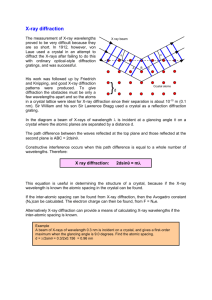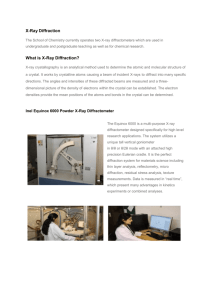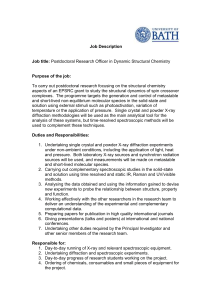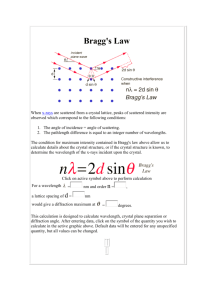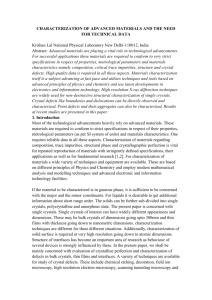File
advertisement
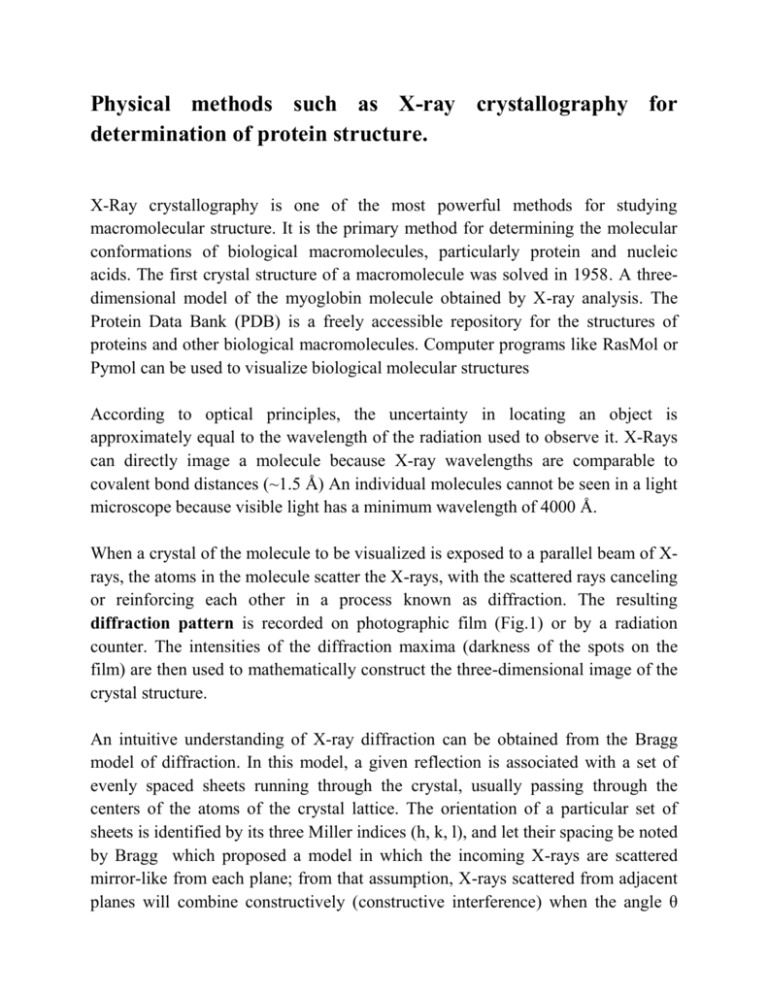
Physical methods such as X-ray crystallography for determination of protein structure. X-Ray crystallography is one of the most powerful methods for studying macromolecular structure. It is the primary method for determining the molecular conformations of biological macromolecules, particularly protein and nucleic acids. The first crystal structure of a macromolecule was solved in 1958. A threedimensional model of the myoglobin molecule obtained by X-ray analysis. The Protein Data Bank (PDB) is a freely accessible repository for the structures of proteins and other biological macromolecules. Computer programs like RasMol or Pymol can be used to visualize biological molecular structures According to optical principles, the uncertainty in locating an object is approximately equal to the wavelength of the radiation used to observe it. X-Rays can directly image a molecule because X-ray wavelengths are comparable to covalent bond distances (~1.5 Å) An individual molecules cannot be seen in a light microscope because visible light has a minimum wavelength of 4000 Å. When a crystal of the molecule to be visualized is exposed to a parallel beam of Xrays, the atoms in the molecule scatter the X-rays, with the scattered rays canceling or reinforcing each other in a process known as diffraction. The resulting diffraction pattern is recorded on photographic film (Fig.1) or by a radiation counter. The intensities of the diffraction maxima (darkness of the spots on the film) are then used to mathematically construct the three-dimensional image of the crystal structure. An intuitive understanding of X-ray diffraction can be obtained from the Bragg model of diffraction. In this model, a given reflection is associated with a set of evenly spaced sheets running through the crystal, usually passing through the centers of the atoms of the crystal lattice. The orientation of a particular set of sheets is identified by its three Miller indices (h, k, l), and let their spacing be noted by Bragg which proposed a model in which the incoming X-rays are scattered mirror-like from each plane; from that assumption, X-rays scattered from adjacent planes will combine constructively (constructive interference) when the angle θ between the plane and the X-ray results in a path-length difference that is an integer multiple n of the X-ray wavelength λ. Where n = number of plane in the protein crystal d = distance between the adjacent plane of the cristal λ = wavelength of the X – ray A reflection is said to be indexed when its Miller indices (or, more correctly, its reciprocal lattice vector components) have been identified from the known wavelength and the scattering angle 2θ. Fig 1: An X-ray diffraction photograph of a crystal of sperm whale myoglobin. The intensity of each diffraction maximum (the darkness of each spot) is a function of the crystal’s electron density. The photograph in Fig 1 represents only a small portion of the total diffraction information available from a crystal of myoglobin, a small globular protein. In contrast, fibrous proteins do not crystallize but, instead, can be drawn into fibers whose X-ray diffraction patterns contain only a few spots and thus contain comparatively little structural information. Similarly the diffraction pattern of a DNA fiber is relatively simple. X-Rays interact almost exclusively with the electrons in matter, not with the atomic nuclei. An X-ray structure is therefore an image of the electron density of the object under study. This information can be shown as a three dimensional contour map (Fig. 3). Fig 3 An electron density map. The threedimensional outline of the electron density (orange) is shown with a superimposed atomic model of the corresponding polypeptide segment (white). This structure is a portion of human rhinovirus Hydrogen atoms, which have only one electron, are not visible in macromolecular X-ray structures. The X-ray structures of small organic molecules can be determined with a resolution on the order of ,1 Å. Few protein crystals have this degree of organization. Furthermore, not all proteins can be coaxed to crystallize, that is, to precipitate in ordered three-dimensional arrays. The protein crystals in Fig. 4 differ from those of most small organic molecules in being highly hydrated; protein crystals are typically 40 to 60% water by volume. The large solvent content gives protein crystals a soft, jellylike consistency so that the molecules are typically disordered by a few angstroms. This limits their resolution to about 2 to 3.5 Å, although a few protein crystals are better ordered (have higher resolution). Figure 4. Protein crystals. (a) Azurin from Pseudomonas aeruginosa, (b) flavodoxin from Desulfovibrio vulgaris, (c) rubredoxin from Clostridium pasteurianum, (d) azidomet myohemerythrin from the marine worm Siphonosoma funafuti, (e) lamprey hemoglobin, and ( f ) bacteriochlorophyll a protein from Prosthecochloris aestuarii. These crystals are colored because the proteins contain light-absorbing groups; proteins are colorless in the absence of such groups. A resolution of a few angstroms is too coarse to clearly reveal the positions of individual atoms, but the distinctive shape of the polypeptide backbone can usually be traced. The positions and orientations of its side chains can therefore be deduced. However, since many side chains have similar sizes and shapes, knowledge of the protein’s primary structure is required to fit the sequence of amino acids to its electron density map. Mathematical techniques can then refine the atomic positions to within ,0.1 Å in higher solution structures. Another consequence of the large solvent content of protein crystals is that crystalline proteins maintain their native conformations and therefore their functions. Indeed, the degree of hydration of proteins in crystals is similar to that in cells. Thus, the X-ray crystal structures of proteins often provide a basis for understanding their biological activities. Crystal structures have been used as starting points for designing drugs that can interact specifically with target proteins under physiological conditions. Recent advances in NMR spectroscopy have permitted the determination of the structures of proteins and nucleic acids in solution (but limited to a size of ,30 kD). Thus, NMR techniques can be used to elucidate the structures of proteins and other macromolecules that fail to crystallize.In the several cases in which both the X-ray and NMR structures of a particular protein were determined, and the two structures had few, if any, significant differences.
